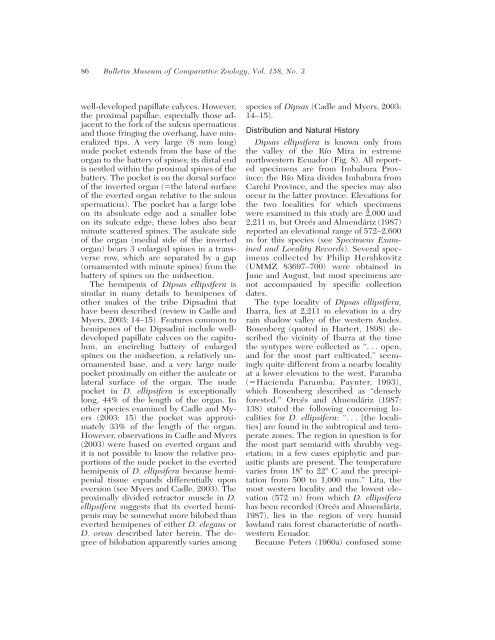systematics of snakes of the dipsas oreas complex - BioOne
systematics of snakes of the dipsas oreas complex - BioOne
systematics of snakes of the dipsas oreas complex - BioOne
You also want an ePaper? Increase the reach of your titles
YUMPU automatically turns print PDFs into web optimized ePapers that Google loves.
86 Bulletin Museum <strong>of</strong> Comparative Zoology, Vol. 158, No. 3<br />
well-developed papillate calyces. However,<br />
<strong>the</strong> proximal papillae, especially those adjacent<br />
to <strong>the</strong> fork <strong>of</strong> <strong>the</strong> sulcus spermaticus<br />
and those fringing <strong>the</strong> overhang, have mineralized<br />
tips. A very large (8 mm long)<br />
nude pocket extends from <strong>the</strong> base <strong>of</strong> <strong>the</strong><br />
organ to <strong>the</strong> battery <strong>of</strong> spines; its distal end<br />
is nestled within <strong>the</strong> proximal spines <strong>of</strong> <strong>the</strong><br />
battery. The pocket is on <strong>the</strong> dorsal surface<br />
<strong>of</strong> <strong>the</strong> inverted organ (<strong>the</strong> lateral surface<br />
<strong>of</strong> <strong>the</strong> everted organ relative to <strong>the</strong> sulcus<br />
spermaticus). The pocket has a large lobe<br />
on its absulcate edge and a smaller lobe<br />
on its sulcate edge; <strong>the</strong>se lobes also bear<br />
minute scattered spines. The asulcate side<br />
<strong>of</strong> <strong>the</strong> organ (medial side <strong>of</strong> <strong>the</strong> inverted<br />
organ) bears 3 enlarged spines in a transverse<br />
row, which are separated by a gap<br />
(ornamented with minute spines) from <strong>the</strong><br />
battery <strong>of</strong> spines on <strong>the</strong> midsection.<br />
The hemipenis <strong>of</strong> Dipsas ellipsifera is<br />
similar in many details to hemipenes <strong>of</strong><br />
o<strong>the</strong>r <strong>snakes</strong> <strong>of</strong> <strong>the</strong> tribe Dipsadini that<br />
have been described (review in Cadle and<br />
Myers, 2003: 14–15). Features common to<br />
hemipenes <strong>of</strong> <strong>the</strong> Dipsadini include welldeveloped<br />
papillate calyces on <strong>the</strong> capitulum,<br />
an encircling battery <strong>of</strong> enlarged<br />
spines on <strong>the</strong> midsection, a relatively unornamented<br />
base, and a very large nude<br />
pocket proximally on ei<strong>the</strong>r <strong>the</strong> asulcate or<br />
lateral surface <strong>of</strong> <strong>the</strong> organ. The nude<br />
pocket in D. ellipsifera is exceptionally<br />
long, 44% <strong>of</strong> <strong>the</strong> length <strong>of</strong> <strong>the</strong> organ. In<br />
o<strong>the</strong>r species examined by Cadle and Myers<br />
(2003: 15) <strong>the</strong> pocket was approximately<br />
33% <strong>of</strong> <strong>the</strong> length <strong>of</strong> <strong>the</strong> organ.<br />
However, observations in Cadle and Myers<br />
(2003) were based on everted organs and<br />
it is not possible to know <strong>the</strong> relative proportions<br />
<strong>of</strong> <strong>the</strong> nude pocket in <strong>the</strong> everted<br />
hemipenis <strong>of</strong> D. ellipsifera because hemipenial<br />
tissue expands differentially upon<br />
eversion (see Myers and Cadle, 2003). The<br />
proximally divided retractor muscle in D.<br />
ellipsifera suggests that its everted hemipenis<br />
may be somewhat more bilobed than<br />
everted hemipenes <strong>of</strong> ei<strong>the</strong>r D. elegans or<br />
D. <strong>oreas</strong> described later herein. The degree<br />
<strong>of</strong> bilobation apparently varies among<br />
species <strong>of</strong> Dipsas (Cadle and Myers, 2003:<br />
14–15).<br />
Distribution and Natural History<br />
Dipsas ellipsifera is known only from<br />
<strong>the</strong> valley <strong>of</strong> <strong>the</strong> Río Mira in extreme<br />
northwestern Ecuador (Fig. 8). All reported<br />
specimens are from Imbabura Province;<br />
<strong>the</strong> Río Mira divides Imbabura from<br />
Carchi Province, and <strong>the</strong> species may also<br />
occur in <strong>the</strong> latter province. Elevations for<br />
<strong>the</strong> two localities for which specimens<br />
were examined in this study are 2,000 and<br />
2,211 m, but Orcés and Almendáriz (1987)<br />
reported an elevational range <strong>of</strong> 572–2,600<br />
m for this species (see Specimens Examined<br />
and Locality Records). Several specimens<br />
collected by Philip Hershkovitz<br />
(UMMZ 83697–700) were obtained in<br />
June and August, but most specimens are<br />
not accompanied by specific collection<br />
dates.<br />
The type locality <strong>of</strong> Dipsas ellipsifera,<br />
Ibarra, lies at 2,211 m elevation in a dry<br />
rain shadow valley <strong>of</strong> <strong>the</strong> western Andes.<br />
Rosenberg (quoted in Hartert, 1898) described<br />
<strong>the</strong> vicinity <strong>of</strong> Ibarra at <strong>the</strong> time<br />
<strong>the</strong> syntypes were collected as ‘‘. . . open,<br />
and for <strong>the</strong> most part cultivated,’’ seemingly<br />
quite different from a nearby locality<br />
at a lower elevation to <strong>the</strong> west, Paramba<br />
(Hacienda Paramba; Paynter, 1993),<br />
which Rosenberg described as ‘‘densely<br />
forested.’’ Orcés and Almendáriz (1987:<br />
138) stated <strong>the</strong> following concerning localities<br />
for D. ellipsifera: ‘‘. . . [<strong>the</strong> localities]<br />
are found in <strong>the</strong> subtropical and temperate<br />
zones. The region in question is for<br />
<strong>the</strong> most part semiarid with shrubby vegetation;<br />
in a few cases epiphytic and parasitic<br />
plants are present. The temperature<br />
varies from 18 to 22 C and <strong>the</strong> precipitation<br />
from 500 to 1,000 mm.’’ Lita, <strong>the</strong><br />
most western locality and <strong>the</strong> lowest elevation<br />
(572 m) from which D. ellipsifera<br />
has been recorded (Orcés and Almendáriz,<br />
1987), lies in <strong>the</strong> region <strong>of</strong> very humid<br />
lowland rain forest characteristic <strong>of</strong> northwestern<br />
Ecuador.<br />
Because Peters (1960a) confused some







